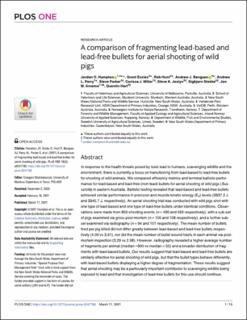A comparison of fragmenting lead-based and lead-free bullets for aerial shooting of wild pigs
Hampton, Jordan O.; Eccles, Grant; Hunt, Rob; Bengsen, Andrew J.; Perry, Andrew L.; Parker, Steve; Miller, Corissa J.; Joslyn, Steve K.; Stokke, Sigbjørn; Arnemo, Jon Martin; Hart, Quentin
Peer reviewed, Journal article
Published version
Permanent lenke
https://hdl.handle.net/11250/2829404Utgivelsesdato
2021Metadata
Vis full innførselSamlinger
Originalversjon
10.1371/journal. pone.0247785Sammendrag
In response to the health threats posed by toxic lead to humans, scavenging wildlife and the environment, there is currently a focus on transitioning from lead-based to lead-free bullets for shooting of wild animals. We compared efficiency metrics and terminal ballistic performance for lead-based and lead-free (non-lead) bullets for aerial shooting of wild pigs (Sus scrofa) in eastern Australia. Ballistic testing revealed that lead-based and lead-free bullets achieved similar performance in precision and muzzle kinetic energy (E0) levels (3337.2 J and 3345.7 J, respectively). An aerial shooting trial was conducted with wild pigs shot with one type of lead-based and one type of lead-free bullets under identical conditions. Observations were made from 859 shooting events (n = 430 and 429 respectively), with a sub-set of pigs examined via gross post-mortem (n = 100 and 108 respectively), and a further subset examined via radiography (n = 94 and 101 respectively). The mean number of bullets fired per pig killed did not differ greatly between lead-based and lead-free bullets respectively (4.09 vs 3.91), nor did the mean number of bullet wound tracts in each animal via postmortem inspection (3.29 vs 2.98). However, radiography revealed a higher average number of fragments per animal (median >300 vs median = 55) and a broader distribution of fragments with lead-based bullets. Our results suggest that lead-based and lead-free bullets are similarly effective for aerial shooting of wild pigs, but that the bullet types behave differently, with lead-based bullets displaying a higher degree of fragmentation. These results suggest that aerial shooting may be a particularly important contributor to scavenging wildlife being exposed to lead and that investigation of lead-free bullets for this use should continue.

